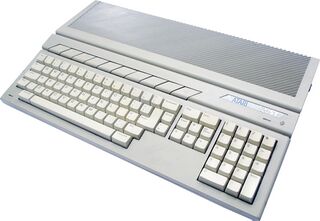Difference between revisions of "Atari ST"
From Sega Retro
(Created page with "{{ConsoleBob | logos= | consoleimage=Atari520ST.jpg | imgwidth= | name= | maker=Atari Corporation | distributor= | variants= | add-ons= }} {{sub-stub}}<section begin=intro...") |
Ccawley2011 (talk | contribs) m |
||
| Line 9: | Line 9: | ||
| add-ons= | | add-ons= | ||
}} | }} | ||
| − | {{sub-stub}}<section begin=intro />The ''' | + | {{sub-stub}}<section begin=intro />The '''Atari ST''' is a line of computers produced by [[Atari Corporation]] from 1985 to 1993. It is a successor to the [[Atari 8-bit]] line.<section end=intro /> |
==Sega support== | ==Sega support== | ||
Revision as of 10:28, 22 April 2017

|
| Atari ST |
|---|
| Manufacturer: Atari Corporation |
This teeny-tiny article needs some work. You can help us by expanding it.
The Atari ST is a line of computers produced by Atari Corporation from 1985 to 1993. It is a successor to the Atari 8-bit line.
Sega support

Like all home computers prior the rise of IBM PC compatibles running Windows 95 (and excluding the Sega-designed SC-3000), Sega did not bring any of its games to the Atari ST directly, instead licensing out arcade properties to the likes of Activision (Mediagenic) and U.S. Gold, which would in turn sub-license development work to smaller studios. Alongside its main competitor, the Amiga, the Atari ST was a market leader of 16-bit computers across Europe in the late 1980s, so was the recepient of many video games.
While initially met with scepticism from the computing industry, the Atari 520ST built up a loyal fanbase from its launch in 1985, particularly in Europe where an estimated 75% of Atari's computers were sold. While not as technically advanced as the Amiga, the ST could deliever competent 16-bit applications for less, and had a two year head start in the gaming market before the 1987 release of the Amiga 500.